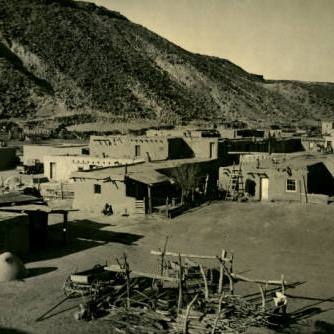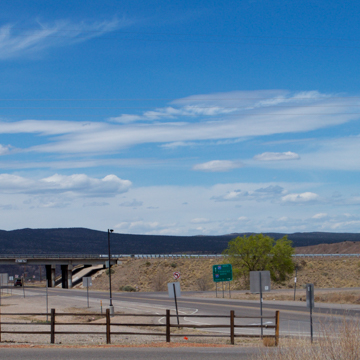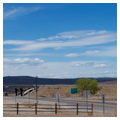You are here
San Felipe Pueblo
Native and Spanish Colonial planning conventions, architectural traditions, and belief systems coexist at San Felipe Pueblo.
Established at its present site in the early 1700s, the pueblo occupies 49,000 acres on the west bank of the Rio Grande, at the foot of the sacred Black Mesa on the southeastern edge of the Jemez Mountains. One of seven Keresan tribes based in the Rio Grande Valley, San Felipe is believed to have descended from the prehistoric pueblos of the Pajarito Plateau, whose inhabitants migrated south in the 1500s.
Called Katishtya in the Keresan language, the original pueblo occupied a site at the foot of the Black Mesa when Francisco Vázquez de Coronado passed through in 1540. Around 1591, Castaño de Sosa rechristened the village San Felipe Apóstol. Fray Cristóbal de Quiñones was assigned as the pueblo’s first missionary soon after Juan de Oñate claimed New Mexico for the Spanish Crown as a province of New Spain in 1598; by 1605, the first mission church of San Felipe had been built by the pueblo under the supervision of Quiñones. Despite being recurrently demoted in status to a visita of the nearby mission at Santo Domingo Pueblo, conversion efforts at San Felipe were apparently successful: Fray Alonso de Benavides reported during his 1626 visit that the pueblo’s entire population of some 350 souls (out of four thousand Keresan in all) had been baptized.
San Felipe joined the Pueblo Revolt of 1680–1692. The church was destroyed and the pueblo abandoned as its inhabitants relocated for safety to the top of Black Mesa. After the Spanish reconquest of New Mexico under Diego de Vargas in 1692–1693, the pueblo entered into a peace agreement with the Spaniards and aided de Vargas in an attack on the neighboring pueblo of Cochití in 1694. That same year, a second mission church was built on the edge of the mesa, where part of its foundations are still visible.
By 1700, when the threat of attack by rival tribes had diminished and perhaps under pressure from the Spaniards, the people of San Felipe relocated again to their present site at the foot of Black Mesa; this site in the floodplain of the Rio Grande was certainly more conducive than the arid mesa to the cultivation of corn, squash, and beans by this agricultural community. Adapting Spanish Colonial planning models, the pueblo was laid out around a central, rectangular plaza bordered tightly by flat-roofed adobe housing blocks. Unlike the typically more sculptural, multi-tiered housing blocks seen at the nearby pueblo of Santo Domingo, the housing blocks at San Felipe are uniform one- and two-story rectangular structures, some with outdoor porticos that reinforce the similarities to Spanish Colonial architecture. This plan, however, is aligned to the four sacred directions of the Keres: the corners of the plaza are oriented north, west, south, and east, and the corner facades are painted in the corresponding Keresan colors of yellow (north), blue (west), red (south), and white (east). The plaza is slightly sunken and used for dances, while it is framed by Black Mesa to the west and the village’s two principal communal spaces, the circular Pumpkin Kiva and Turquoise Kiva, to the north and east.
Begun in 1706, the mission church of San Felipe lies to the south. Planned and built as an integral part of the pueblo, the church nonetheless stands apart as it faces east to the Rio Grande in its own, separate space. This space is clearly demarcated on the exterior by the walled cemetery or camposanto that extends from the church facade and is wrapped in turn by a large open plaza.
Shaped physically and culturally both by Native and by Spanish Colonial conventions and beliefs, the pueblo’s religious celebrations reflect the dialogue between traditions that has informed San Felipe since the early eighteenth century. On May 1, the annual feast day of San Felipe, a statue of the patron saint is carried in a ritual procession from the church to the main plaza, while dancers emerge from the kivas and move toward the camposanto, where they perform the year’s first Corn Dance before moving on to the main plaza.
Having assimilated Spanish ideas and practices, San Felipe continues to negotiate outside forces, influences, and economic realities. With a population of some 3,500 inhabitants, the pueblo maintains a tribally owned and operated casino, motorsports track, restaurant, gift shop, and gas station, and those residents not employed by the tribal government, schools, health systems, and tribally owned businesses work in nearby cities.
At the same time, San Felipe is one of the most culturally conservative pueblos, in which a matrilineal clan structure and the native Keresan language remain important. Agricultural production is still a primary source of subsistence and income for the community, which continues to practice traditional arts and crafts, producing pottery, woven baskets and sashes, and moccasins.
Except for specific celebrations, like the annual feast day of San Felipe, the pueblo is closed to the public.
References
Adams, Eleanor and Fray Angelico Chavez. The Missions of New Mexico, 1776: A Description by Fray Francisco Atanasio Domínguez with Other Contemporary Documents. Albuquerque: University of New Mexico Press, 1956.
Dutton, Bertha Pauline. American Indians of the Southwest. Albuquerque: University of New Mexico Press, 1983.
“Katishtya (San Felipe Pueblo).” School for Advanced Research. Accessed March 15, 2016. https://sarweb.org/.
Kessel, John L. The Missions of New Mexico Since 1776. Albuquerque: University of New Mexico, 1980.
Kubler, George. The Religious Architecture of New Mexico In the Colonial Period and Since the American Occupation. 1940. Reprint, Albuquerque: University of New Mexico Press, 1972.
Ortiz, Alfonso, ed. Handbook of North American Indians: Southwest. Washington, D.C.: Smithsonian Institution, 1979.
Pritzker, Barry. A Native American Encyclopedia: History, Culture, and Peoples. New York: Oxford University Press, 2000.
Purdy, James, “Pueblo of San Felipe (Katishtya),” Sandoval County, New Mexico. New Mexico State Register of Cultural Properties Application for Registration Form, 1972. New Mexico Historic Preservation Division, Santa Fe, NM.
Scully, Vincent. Pueblo/Mountain, Village, Dance. New York: Viking Press, 1972.
Treib, Marc. Sanctuaries of Spanish New Mexico. Berkeley: University of California Press, 1993.
Wilson, Chris, and Stefanos Polyzoides. The Plazas of New Mexico. San Antonio, TX: Trinity University Press, 2011.
Writing Credits
If SAH Archipedia has been useful to you, please consider supporting it.
SAH Archipedia tells the story of the United States through its buildings, landscapes, and cities. This freely available resource empowers the public with authoritative knowledge that deepens their understanding and appreciation of the built environment. But the Society of Architectural Historians, which created SAH Archipedia with University of Virginia Press, needs your support to maintain the high-caliber research, writing, photography, cartography, editing, design, and programming that make SAH Archipedia a trusted online resource available to all who value the history of place, heritage tourism, and learning.













